posted by Dave Arnold
Ike Jime is a Japanese fish killing technique. The spinal cord and main blood vessels are severed at the head and tail, a long needle is pushed down the spinal cord, and the fish is placed in ice water to bleed out.
Several months ago, Dave Chang of Momofuku fame called me and said, “We have to investigate this Ike Jime thing. McGee says it’s bullshit.”
I am pretty sure McGee (that would be Harold McGee, master blaster of science in the kitchen) didn’t say that Ike Jime was bullshit, but rather that he couldn’t think of any reason it would make a difference in the taste of the fish. The part about cutting at the head and the tail and allowing the fish to bleed isn’t really in dispute. This technique does get the blood out. The question is: does the needle in the spine do anything? The Japanese insist that the needle is important because it ensures that the muscle “doesn’t know it is dead.” Skeptics wonder what the point of skewering the spine is after the spinal cord has been cut.
Nils and I set out to do some Ike Jime experiments at the school. We needed an unimpeachable expert so we could make sure it was done correctly. Friend of the school Saori Kawano, from Korin knives, put us in touch with Chef Toshio Suzuki, of Sushi Zen in NYC (btw, if you don’t know Korin, check out their website here. Make sure you have a napkin to wipe up the drool). Sushi Zen is one of the most highly regarded sushi restaurants in New York. Chef Suzuki graciously agreed to come in and demonstrate the technique. I confirmed with Chang, made sure Mindy could come, and the test was set up for last Monday.
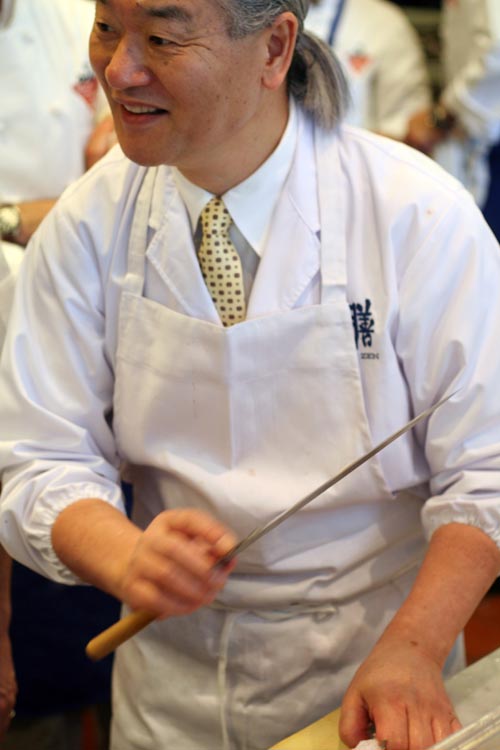
Chef Suzuki
Here’s what we wanted to do: Get 6 live fluke and 2 dead fluke. We would kill 2 fish Western style, 2 Japanese style without the needle, and 2 with full Ike Jime, and then taste the difference between them and the 2 dead fluke. Chef Suzuki said that the technique would be unnecessary and difficult on the fluke we could get, because their spinal cords would be too small. He suggested bass instead (btw his name means bass in Japanese). OK. We ordered live bass. They didn’t have stripers so we got black bass. I called Dave Chang to re-confirm he could come—yes, but he definitely wanted different types of fish, including fluke. OK. We ordered the live fluke as well.
The day of the test, after Chang and Suzuki had shown up with Taeko Takigami from the Gohan Foundation, I realized that the fish company had taken the liberty of killing the fish for us. I guess they thought they we doing us a favor. Crap. Nils was wrapping something else up and I was staring at a box of dead fish, so I ran like a demon to Hong-Kong Supermarket 6 blocks away. Hong Kong, in the heart of Chinatown, always has live fish in their tanks. That day they had farmed stripers and barramundi. I had to find the guy who spoke English so I could explain that I needed to buy them live and put them in trash bags full of seawater. I was worried, because I have had trouble getting special service here in the past. To my surprise, they agreed. I think they were amused by the idea of some nut running out of the store with trash bags full of water because they were unusually helpful. I blasted out of that place with 16 fish in two big bags. When I got back to the school I thought my arms would fall off.
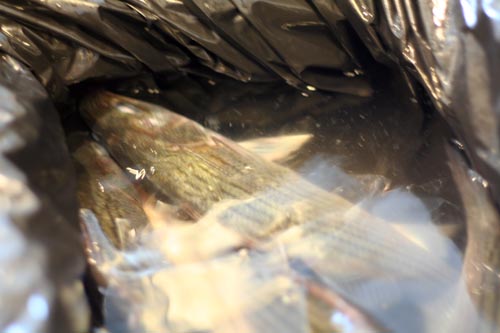
Live fish in a trash bag
And then I found out the fish company was sending over more live fish to make up for their error. Crap. More types of fish made for a better test anyway, I guess. They were bringing live fluke and black bass, and I had stripers and barramundi. We didn’t have any traditional dead fish-store fish (the fish guys wanted their dead fish back in return for the new live ones), so we wouldn’t have that part of our test. Oh well. We set up a giant Lexan of ice water and got to work.
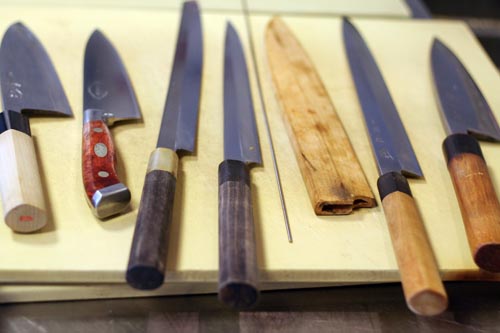
Part of Suzuki's knife kit. 2 debas, 2 yanagis, the needle, a saya cover, and another yanagi and deba.
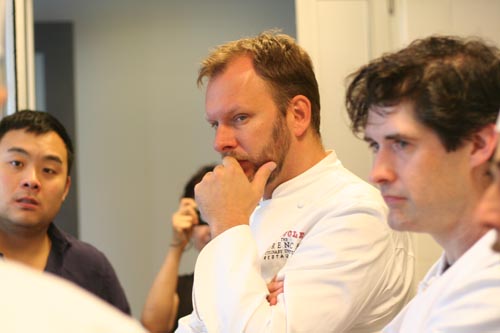
Listening to Suzuki.
First we did our Western-style fisherman’s kill. We took 2 barramundi, 2 stripers, 2 fluke, and 2 black bass and put them in a bucket. They didn’t die so fast so I put them down with a whack over the head—more humane, although it didn’t feel so good.
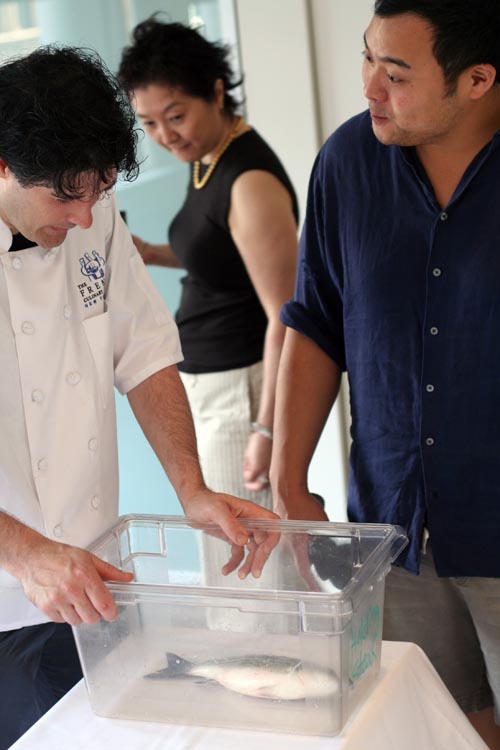
Chang, Taeko, and I contemplate whacking a striper.
Then Chef Suzuki got to work. He picked up a striper and laid it down on the cutting board, head facing right, stroking it a couple of times. “If you are relaxed the fish will be relaxed,” he said. Then he took his deba (a type of Japanese fish knife that I really like), put the point under and behind the gills right next to the spinal cord and pushed in, severing the spinal cord and blood vessels instantly.
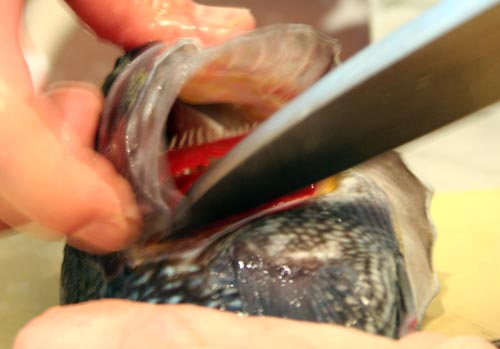
Live black bass tend to flare their gills, giving a good view of where to put the knife for the kill.
He then pushed down on the back of the knife with his hand until the blade just started to make a mark in the bottom of the gill area and held that position for about 10 seconds. He said that step is important because it helps control convulsions and helps the fish to “continue breathing on its own.” I dunno, that’s what he said.

Pushing the knife down so the fish can "breathe on its own" and not convulse.
Then he cut through the spine at the tail, making sure he severed everything without actually removing the tail (removing the tail makes scaling more difficult, as I learned later when I accidentally took off the whole tail). Then he took a fine needle and ram-rodded it up the spinal cord from the rear. After a couple of seconds he took out the needle, and immediately put the fish into the ice water. As he did so, he pointed out that you want to keep the body straight but bend out the cut tail and gill part to allow for free bleeding. This, more or less, was the procedure we followed with all of the ike jime fish. The spinal cord on the fluke was, indeed, quite small. We were only able to get the needle into one of them, and not even all the way. Suzuki had us do the technique and tell us right from wrong, so we could do it ourselves next time. The rest of the fish we bled with the same technique but skipped the needle.
Here is the technique start to finish in photos:
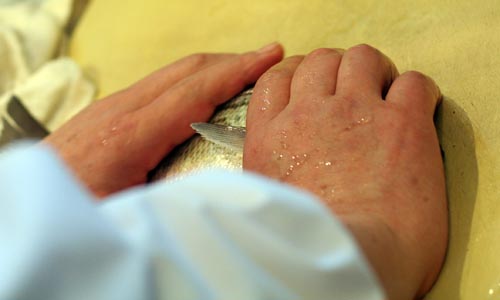
Holding down a striper. If you are relaxed, the fish will be relaxed.
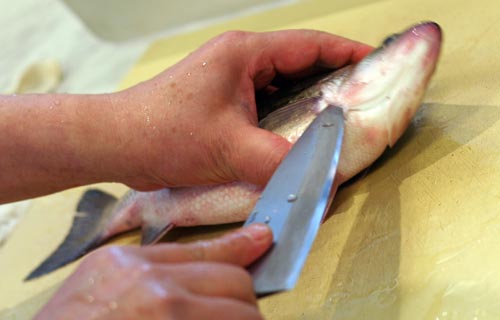
Put your knife under the gill flap and behind the gills at the top of the fish...
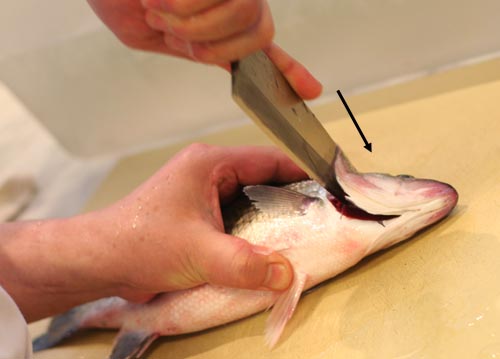
... and push down to sever the spine and blood vessels.
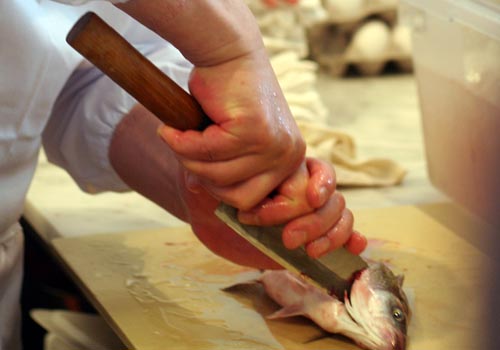
Press down on the blade for several seconds.
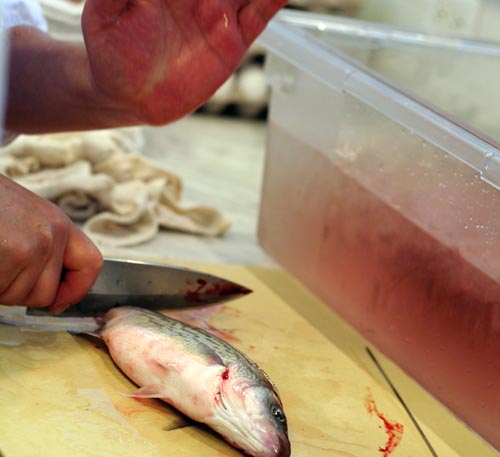
Sever the spine and blood vessels at the tail. Suzuki is about to give the knife a whack with his hand.

Shove a needle all the way down the spine of the fish. This is the mystical part of ike jime. This is supposed to make the muscles "not even know they are dead."
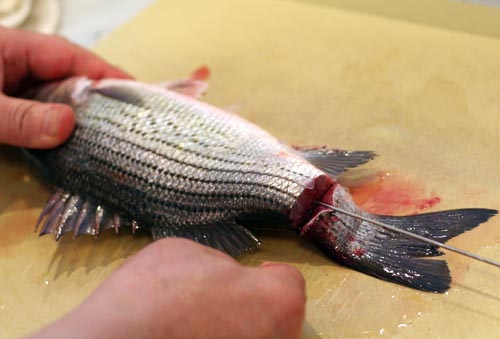
Needle in the spine, ready to go in the water.

Putting a fluke in ice water to bleed out. The heart is still pumping so we are using the fishes own circulatory system to rid it of blood. I am bending the body too much here according to Suzuki. The head and tail should be bent but the body should be straight.
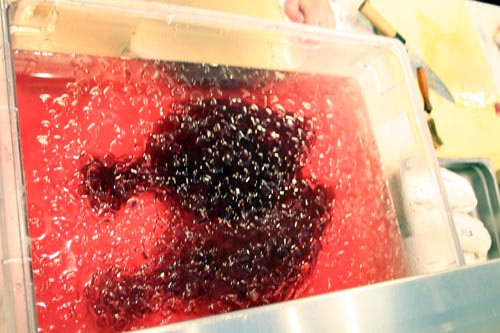
The fluke water gets rather gory. We called it fluke punch.
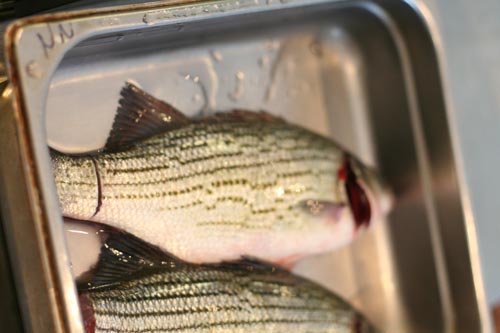
Finished stripers
Some notes: the technique of severing the spine by going through the gills is good because it preserves the look of the head. It is also acceptable to cut the spinal cord from above; it just isn’t as pretty and doesn’t have the “press with the knife for breathing” trick. Chef Suzuki put the needle in from the rear because it can’t go in from the front without damaging the head. Nils and I think that going in from the front would definitely be easier if the head doesn’t need to be pretty. Also, getting the needle into the spine is much more difficult if you don’t sever the spine in between the vertebrae. Suzuki was good at this, we weren’t.
Suzuki also showed us the really cool technique of cutting the scales off a fluke using a yanagi (a Japanese fish slicer). I was better at it than I thought I’d be. Of course Nils was good at it. Here is the technique:
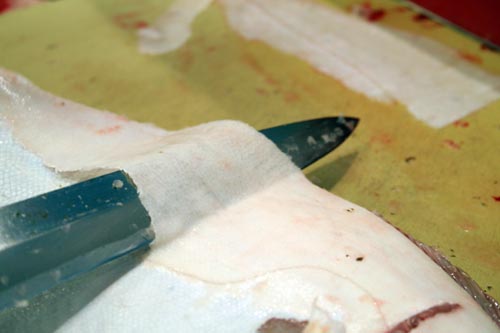
Using a yanagi, the scales are cut off of a fluke in a paper-thin layer without damaging the skin. Serious badass technique.
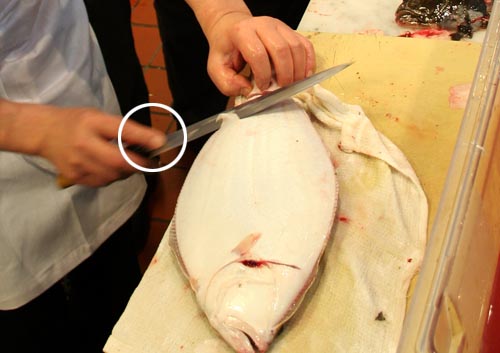
Cutting the scales off of fluke. Here is the belly side. First cut off a strip of scales running down the middle of the fish (not shown in this photo). Hold the tail of the fish with your left hand. Hold the yanagi flat against the fish. Don't press into the fish at all. Saw back and forth with the knife to cut the scales in an even strip. Notice the finger on top of the yanagi (in the circle) this helps guide the knife and makes cutting more accurate. After the middle strip is cut, put the fish on the edge of the board and cut off the scales at an angle (shown in this photo).
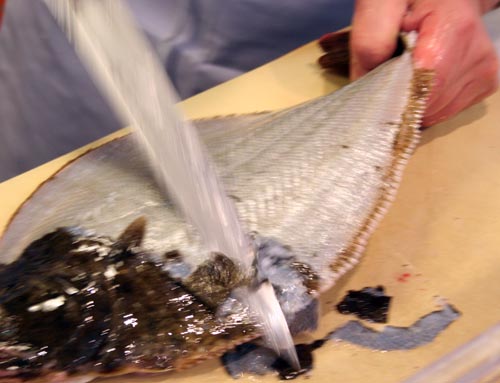
Here is the top side of the fluke being scaled. When cutting the scales off the the far side of the fish, grasp the tail and turn it as shown. This twist in the fish helps line up the knife along the flesh of the fish and allows for long even strokes. You want the yanagi to make long strokes. If the surface of the fish dries out, wet it a little to make cutting easier (but not on the bottom or it will get slippery!).
More cool stuff:
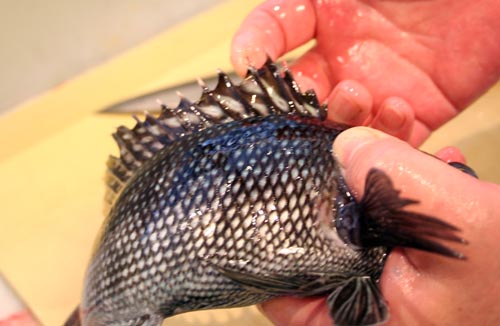
Chef Suzuki shows the proper way to hold a black bass, gripping tightly around the gills. Improper holding can get you pricked with the fins, causing a bad infection.

Cleaning the inside of the fish. Run the knife down both sides of the spine, then scrub under water with a fish brush. The brush is awesome. It really gets the inside clean.
At this point Chang had to leave so he didn’t get to taste anything. He vowed to do more tests. “This is just the preliminary,” he said. He has some far-ranging Ike-Jime test schemes that I cannot reveal.
After the fish had rested for a couple of hours, Suzuki San sashimied up some fish for us to taste.
The results? Stay tuned!

STAY TUNED??? Bastard! ARGHHAHRRHHRHAHRHHHH!
my favorite post period. i know it was probably hard to just kill those fish for the sake of an experiment but it seems like you guys learned quite a bit. great post.
wow you killed me with the stay tuned, damn cliffhanger on a blog. really interesting post thought cant wait to read the follow up
Awesome writeup.
Cliffhanger though?! Gah…
:o) And I thought I had it hard filleting a fluke in Level 1!
Awesome and inspiring !2 4
This post is intense jajajaja I loved it!
I’m living in Tokyo now, so there are too many people for chefs to really show off what they can do but, at one of my favorite places in Nakasu in Fukuoka Nakamura-san, the owner/chef for 25 years, has shown me this move so quickly and effortlessly with aji, that when I tried at home with hamachi and could only vaguely do, it was difficult to remember his handiwork.
Nice work.
Great photo sequence which really illustrrates the complexity and skill involved.
This has got to be the most interesting read on food for me this year. inspiring!
Hi, I’m going to post a couple of photos of bleeding out sea bream at an aquaculture farm in Japan.
http://commonerrorsjtoe.blogspot.com/
At the Boston Seafood show, there will be a yellowtail company that makes a big deal of its ikejime processing. I doubt they do the whole needle thing though. More likely just the gill jab and bleeding out.
http://www.japan-seafood.net/english/ex08.html
Regards,
Chris Loew
(SeafoodSource .com Japan correspondent)
Fishing Chit Chat | Interesting discussions on slaughtering fish (Ike Jime) // Sep 19, 2011 at 7:50 pm
[...] this blog while researching Ike Jime and the way the japanese are slaughtering fish these days: http://www.cookingissues.com/2009/08…ckdown-part-1/ Cliffs: Don't just bleed your fish–make a cut at the top of the head and tail and jam piano wire [...]